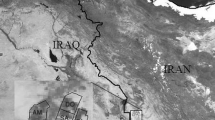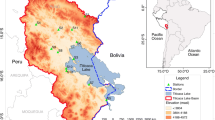Abstract
Accurate prediction of the reference evapotranspiration (ET0) is vital for estimating the crop water requirements precisely. In this study, we developed multi-layer perceptron artificial neural network (MLP-ANN) models considering different combinations of the meteorological data for predicting the ET0 in the Beas-Sutlej basin of Himachal Pradesh (India). Four climatic locations in the basin namely, Kullu, Mandi, Bilaspur, and Chaba were selected. The meteorological dataset comprised air temperature (maximum, minimum and mean), relative humidity, solar radiation, and wind speed, recorded daily for a period of 35 years (1984–2019). The datasets from 1984 to 2012 and 2013 to 2019 were utilized for training and testing the models, respectively. The performance of the developed models was evaluated using several statistical indices. For each location, the best performed MLP-ANN model was the one with the complete combination of the meteorological data. The architecture of the best performing model for Kullu, Mandi, Bilaspur, and Chaba was (6–2-4–1), (6–5-4–1), (6–5-4–1), and (6–4-6–1), respectively. It was observed, however, that the performance of other models was also relatively good, given the limited meteorological data utilized in those models. Further, to appreciate the relative predictive ability of the developed models, a comparison was performed with four existing established empirical models. The approach adopted in this study can be effectively utilized by water users and field researchers for modelling and predicting ET0 in data-scarce locations.





Similar content being viewed by others
Data availability
Some data, models, or code used during the study are available from the first author and corresponding author by request.
References
Adamala, S., Raghuwanshi, N. S., Mishra, A., & Singh, R. (2019). Generalized wavelet neural networks for evapotranspiration modeling in India. ISH Journal of Hydraulic Engineering, 25(2), 119–131.
Adeloye, A. J., Rustum, R., & Kariyama, I. D. (2012). Neural computing modeling of the reference crop evapotranspiration. Environmental Modelling & Software, 29(1), 61–73.
Adisa, O. M., Botai, J. O., Adeola, A. M., Hassen, A., Botai, C. M., Darkey, D., & Tesfamariam, E. (2019). Application of artificial neural network for predicting maize production in South Africa. Sustain, 11, 1–17. https://doi.org/10.3390/su11041145
Akcayol, M. A., & Cinar, C. (2005). Artificial neural network based modeling of heated catalytic converter performance. Applied Thermal Engineering, 25, 2341–2350. https://doi.org/10.1016/j.applthermaleng.2004.12.014
Allen, R. G., Pereira, L. S., Raes, D., & Smith, M. (1998). FAO Irrigation and drainage paper No. 56. Rome: Food and Agriculture Organization of the United Nations, 56(97), e156.
Almorox, J., & Grieser, J. (2015). Calibration of the Hargreaves-Samani method for the calculation of reference evapotranspiration in different Köppen climate classes. Hydrology Research, 47(2), 521–531.
Antonopoulos, V. Z., & Antonopoulos, A. V. (2017). Daily reference evapotranspiration estimates by artificial neural networks technique and empirical equations using limited input climate variables. Computers and Electronics in Agriculture, 132, 86–96.
Chia, M. Y., Huang, Y. F., Koo, C. H., & Fung, K. F. (2020). Recent advances in evapotranspiration estimation using artificial intelligence approaches with a focus on hybridization techniques—A review. Agronomy, 10(1), 101.
Dold, C., Heitman, J., Giese, G., Howard, A., Havlin, J., & Sauer, T. (2019). Upscaling evapotranspiration with parsimonious models in a North Carolina Vineyard. Agronomy, 9(3), 152.
Elbeltagi, A., Deng, J., Wang, K., & Hong, Y. (2020a). Crop Water footprint estimation and modeling using an artificial neural network approach in the Nile Delta, Egypt. Agricultural Water Management, 235, 106080. https://doi.org/10.1016/j.agwat.2020.106080
Elbeltagi, A., Deng, J., Wang, K., Malik, A., & Maroufpoor, S. (2020b). Modeling long-term dynamics of cropevapotranspiration using deep learning in a semi-arid environment. Agricultural Water Management, 241, 106334. https://doi.org/10.1016/j.agwat.2020.106334
Elbeltagi, A., Zhang, L., Deng, J., Juma, A., & Wang, K. (2020c). Modeling monthly crop coefficients of maize basedon limited meteorological data: A case study in Nile Delta, Egypt. Computers and Electronics in Agriculture, 173, 105368. https://doi.org/10.1016/j.compag.2020.105368
Elbeltagi, A., Rizwan, M., Malik, A., Mehdinejadiani, B., Srivastava, A., Singh, A., & Deng, J. (2020d). The impact of climate changes on the water footprint of wheat and maize production in the Nile Delta, Egypt. The Science of the Total Environment, 743, 140770. https://doi.org/10.1016/j.scitotenv.2020.140770
Elbeltagi, A., Rizwan, M., Mokhtar, A., Deb, P., Abdullahi, G., Kushwaha, N. L., Peroni, L., Malik, A., Kumar, N., & Deng, J. (2020e). Spatial and temporal variability analysis of green and blue evapotranspiration of wheat in the Egyptian Nile Delta from 1997 to 2017. Journal of Hydrology, 125662. https://doi.org/10.1016/j.jhydrol.2020.125662
Falamarzi, Y., Palizdan, N., Feng, Y., & Shui, T. (2014). Estimating evapotranspiration from temperature and wind speed data using artificial and wavelet neural networks ( WNNs ). Agricultural Water Management, 140, 26–36. https://doi.org/10.1016/j.agwat.2014.03.014
Fan, J., Wu, L., Zhang, F., Cai, H., Ma, X., & Bai, H. (2019). Evaluation and development of empirical models for estimating daily and monthly mean daily diffuse horizontal solar radiation for different climatic regions of China. Renewable and Sustainable Energy Reviews, 105, 168–186.
Fan, J., Wu, L., Zhang, F., Xiang, Y., & Zheng, J. (2016). Climate change effects on reference crop evapotranspiration across different climatic zones of China during 1956–2015. Journal of Hydrology, 542, 923–937.
Feng, Y., Peng, Y., Cui, N., Gong, D., & Zhang, K. (2017). Modeling reference evapotranspiration using extreme learning machine and generalized regression neural network only with temperature data. Computers and Electronics in Agriculture, 136, 71–78.
Ferreira, L. B., da Cunha, F. F., de Oliveira, R. A., & Fernandes Filho, E. I. (2019). Estimation of reference evapotranspiration in Brazil with limited meteorological data using ANN and SVM–A new approach. Journal of Hydrology, 572, 556–570.
Jamshidi, S., Zand-Parsa, S., Kamgar-Haghighi, A. A., Shahsavar, A. R., & Niyogi, D. (2020). Evapotranspiration, crop coefficients, and physiological responses of citrus trees in semi-arid climatic conditions. Agricultural Water Management, 227, 105838.
Khosravi, K., Mao, L., Kisi, O., Yaseen, Z. M., & Shahid, S. (2018). Quantifying hourly suspended sediment load using datamining models: Case study of a glacierized Andean catchment in Chile. Journal of Hydrology, 567, 165–179.
Kisi, O. (2008). The potential of different ANN techniques in evapotranspiration modelling. Hydrological Processes: An International Journal, 22(14), 2449–2460.
Kose, E. (2008). Modelling of colour perception of different age groups using artificial neural networks. Expert Systems with Applications, 34, 2129–2139. https://doi.org/10.1016/j.eswa.2007.02.036
Kumar, M., Raghuwanshi, N. S., & Singh, R. (2011). Artificial neural networks approach in evapotranspiration modeling: A review. Irrigation Science, 29(1), 11–25.
Kumar, M., Raghuwanshi, N. S., Singh, R., Wallender, W. W., & Pruitt, W. O. (2002). Estimating evapotranspiration using artificial neural network. Journal of Irrigation and Drainage Engineering, 128(4), 224–233.
Kumar, N., Adeloye, A. J., Shankar, V., & Rustum, R. (2020). Neural computing modelling of the crop water stress index. Agricultural Water Management, 239, 106259.
Kumar, R., Jat, M. K., & Shankar, V. (2012). Methods to estimate irrigated reference crop evapotranspiration–a review. Water Science and Technology, 66(3), 525–535.
Luo, Y., Traore, S., Lyu, X., Wang, W., Wang, Y., Xie, Y., Jiao, X., & Fipps, G. (2015). Medium range daily reference evapotranspiration forecasting by using ANN and public weather forecasts. Water Resources Management, 29(10), 3863–3876.
Naganna, S. R., Deka, P. C., Ghorbani, M. A., Biazar, S. M., Al-Ansari, N., & Yaseen, Z. M. (2019). Dew point temperature estimation: Application of artificial intelligence model integrated with nature-inspired optimization algorithms. Water, 11(4), 742.
Nandagiri, L., & Kovoor, G. M. (2006). Performance evaluation of reference evapotranspiration equations across a range of Indian climates. Journal of Irrigation and Drainage Engineering, 132(3), 238–249.
Nema, M. K., Khare, D., & Chandniha, S. K. (2017). Application of artificial intelligence to estimate the reference evapotranspiration in sub-humid Doon valley. Applied Water Science, 7, 3903–3910. https://doi.org/10.1007/s13201-017-0543-3
Poddar, A., Gupta, P., Kumar, N., Shankar, V., & Ojha, C. S. P. (2018). Evaluation of reference evapotranspiration methods and sensitivity analysis of climatic parameters for sub-humid sub-tropical locations in western Himalayas (India). ISH Journal of Hydraulic Engineering, 1–11. https://doi.org/10.1080/09715010.2018.1551731
Sentelhas, P. C., Gillespie, T. J., & Santos, E. A. (2010). Evaluation of FAO Penman-Monteith and alternative methods for estimating reference evapotranspiration with missing data in Southern Ontario Canada. Agricultural Water Management, 97(5), 635-644.
Shankar, V., Ojha, C. S. P., Govindaraju, R. S., Prasad, K. H., Adebayo, A.J., Madramoottoo, C. A.,… Singh, K. K. (2017). Optimal use of irrigation water. In C. S. P. Ojha, Y. R. Surampalli, & A. Bardossy (Eds.), Sustainable water resources management (pp. 737–795). Reston, VA: American Society of Civil Engineers.
Sudheer, K. P., Gosain, A. K., & Ramasastri, K. S. (2003). Estimating actual evapotranspiration from limited climatic data using neural computing technique. Journal of Irrigation and Drainage Engineering, 129(3), 214–218.
Tabari, H. (2010). Evaluation of reference crop evapotranspiration equations in various climates. Water resources management, 24(10), 2311-2337.
Tabari, H., Grismer, M. E., & Trajkovic, S. (2013). Comparative analysis of 31 reference evapotranspiration methods under humid conditions. Irrigation Science, 31(2), 107–117.
Trajkovic, S., & Kolakovic, S. (2009). Evaluation of reference evapotranspiration equations under humid conditions. Water Resources Management, 23(14), 3057–3067.
Traore, S., Wang, Y. M., & Kerh, T. (2010). Artificial neural network for modeling reference evapotranspiration complex process in Sudano-Sahelian zone. Agricultural Water Management, 97, 707–714. https://doi.org/10.1016/j.agwat.2010.01.002
Yassin, M. A., Alazba, A. A., & Mattar, M. A. (2016). Artificial neural networks versus gene expression programming for estimating reference evapotranspiration in arid climate. Agricultural Water Management, 163, 110–124.
Funding
The work was supported by National Institute of Technology Hamirpur (India), Shoolini University (India), and Mansoura University (Egypt).
Author information
Authors and Affiliations
Contributions
Navsal Kumar and Ahmed Elbeltagi conceived the idea of the paper. Ahmed Elbeltagi and Chaitanya B. Pande performed the modelling simulations. Ahmed Elbeltagi compiled the results. Navsal Kumar, Ahmed Elbeltagi and Abhishish Chandel drafted the original manuscript. Abu Reza Md. Towfiqul Islam and Ahmed Awad reviewed the manuscript. All authors read and approved the final version of manuscript.
Corresponding author
Ethics declarations
Conflict of interest
The authors declare no competing interests.
Additional information
Publisher's Note
Springer Nature remains neutral with regard to jurisdictional claims in published maps and institutional affiliations.
Rights and permissions
About this article
Cite this article
Elbeltagi, A., Kumar, N., Chandel, A. et al. Modelling the reference crop evapotranspiration in the Beas-Sutlej basin (India): an artificial neural network approach based on different combinations of meteorological data. Environ Monit Assess 194, 141 (2022). https://doi.org/10.1007/s10661-022-09812-0
Received:
Accepted:
Published:
DOI: https://doi.org/10.1007/s10661-022-09812-0




